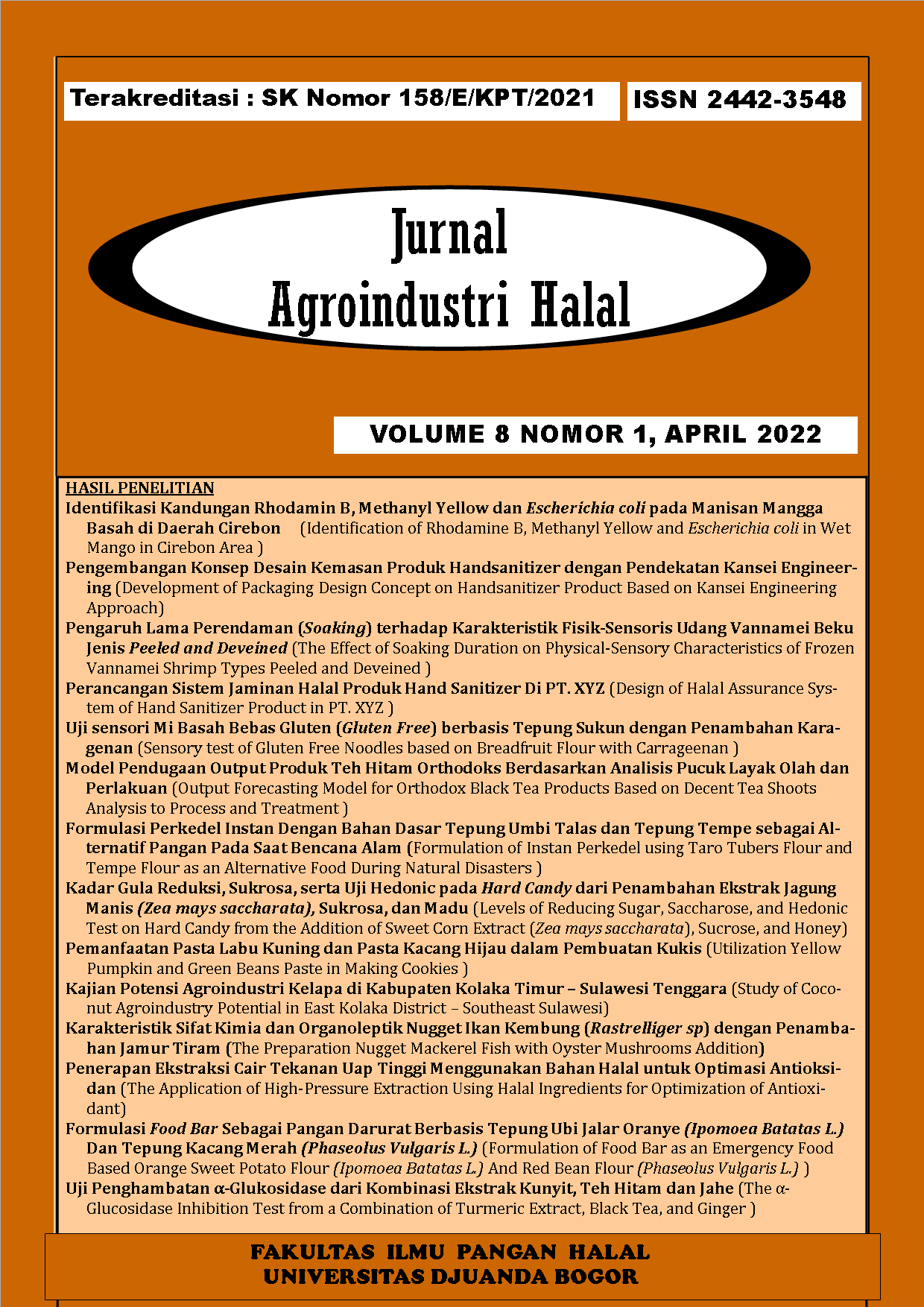Pemanfaatan Pasta Labu Kuning dan Pasta Kacang Hijau dalam Pembuatan Kukis
DOI:
https://doi.org/10.30997/jah.v8i1.4508Keywords:
cookies, yellow pumpkin paste, green beans pasteAbstract
Cookies are a type of snack that tastes sweet, has a crunchy texture, made from flour with other additives such as eggs, margarine, powdered sugar, and powdered milk. The purposes of this study was to obtain the best ratio of pumpkin and green beans paste in making cookies that meet the quality of SNI 01-2973-2011. The study was conducted using a completely randomized design (CRD) with four treatments and four replications. The treatment in this research was the diference of the ratio between yellow pumpkin paste and green beans paste, namely LK1 (65:5), LK2 (60:10), LK3 (55:15), and LK4 (50:20). The parameters to be observed are moisture, ash, protein, fat, carbohydrate, β-karoten, crude fiber, as well as descriptive and hedonic sensory tests. Data were analyzed using analysis of variance (ANOVA) and then continued with Duncan’s multiple range test (DMRT) at 5% level. The result showed that the ratio of yellow pumpkin paste and green beans paste significantly affected moisture, ash, protein, fat, carbohydrate, crude fiber, β-karoten, as well descriptive and hedonic sensory tests. The ratio of yellow pumpkin paste amd green beans paste (65:5) was chosen as the best treatment which had 3.26% protein, 5.79% moisture, 2.15% ash, 17.84% fat, 71.97% carbohydrate, 2.19% crude fiber, and 17.53 µg/g β-karoten with a description of yellow, pumpkin yellow flavored, slightly crunchy texture, and yellow pumpkin taste. Hedonic assessment of color, aroma, cruncy texture, taste, and overall assessment were liked by panelists.
References
Agustin, V., Sugitha I. M., & Sandhi, P. A. (2017). Pengaruh perbandingan terigu dengan puree labu kuning (Cucurbita moschata ex. Poir) terhadap karakteristik kue lumpur. Jurnal ITEPA, 6(2), 11-20.
Andarwulan, N., Kusnandar, F., & Herwati, D. (2011). Analisis Pangan. Dian Rakyat.
Badan Standardisasi Nasional. (2011). SNI 01-2973-2011. Syarat Mutu dan Cara Uji Biskuit. Badan Standardisasi Nasional.
Elmore, J. S., Campo, M. M., Enser, M., & Mottram, D. S. (2002). Effect of lipid composition on meat-like model system containing cysteine, ribose and polyunsaturated fatty acids. Journal Agriculture Food Chemistry, 50, 1126-1132.
Estiasih, T., Harijono, Waziiroh, E., & Fibrianto, K. (2018). Kimia dan Fisik Pangan. Bumi Aksara.
Fellows, P. J. (2000). Food processing technology, principle and practice. 2nd Ed. CRC Press.
Kusumaningrum, A, & Rahayu, W. P. (2007). Penambahan kacang-kacangan dalam formulasi makanan pendamping air susu ibu (MP-ASI) berbahan dasar pati aren (Arenga pinnata (Wurmb) Merr). Jurnal Teknologi dan Industri Pangan, 18(2), 73-80.
Leffingwell, J. C., Alford, E. D., & Leffingwell, D. (2015). Identification of the volatile constituents of raw pumpkin (Cucurbita pepo L.) by dynamic headspace analyses. Leffingwell Reports, 7(1),1-14.
Mahmud, M. K, Hermana, Zulfianto, N. A., Rozanna, R., Apriyantono, Ngadiarti, I., Hartati, B., Bernadus, & Tinexcelly. (2018). Tabel Komposisi Pangan Indonesia. Kompas Gramedia.
Muchtadi, D. (2001). Sayuran sebagai sumber serat pangan untuk mencegah timbulnya penyakit degeneratif. Jurnal Teknologi dan Industri Pangan, 12, 1-2.
Potocnik, T., & Kosir, I. J. (2016). Ifluence of roasting temperature of pumpkin seed on PAH and aroma formation. Europe Journal Lipid Science Technology, 119(3), 1-8.
Prahesti, H., Praptaningsih, Y., & Yuli, W. (2016). Karakteristik Bihun Campuran Tepung Ganyong (Canna edulis) dan Tepung Wortel (Daucus carota) dengan Penambahan Tapioka. [Skripsi, Universitas Jember]. Repository Universitas Jember.
Pratiwi, M. A. (2008). Pemanfaatan Tepung Hotong (Setaria italica L. Beauv) dan Pati Sagu dalam Pembuatan Cookies. [Skripsi, Institut Pertanian Bogor]. IPB University Scientific Repository.
Primasari, A., & Haryadi, A. (2006). Kajian Pemanfaatan Puree Waluh (Cucurbita pepo Linn.) dalam Pembuatan Cookies. [Skripsi, Institut Pertanian Bogor]. IPB University Scientific Repository.
Priyono, E., Ninsix, R., & Apriyanto, M. (2018). Studi pencampuran labu kuning (Cucurbita moschata) dengan tepung beras terhadap karakteristik biskuit yang dihasilkan. Jurnal Teknologi Pertanian, 7(1), 11-17.
Setyaningsih, D., & Apriyantono, A., Sari, M. P. (2010). Analisis Sensori untuk Industri Pangan dan Agro. IPB Press.
Sipayung, E. (2014). Potensi Tepung Ubi Jalar Ungu (Ipomea batatas L.), Tepung Tempe dan Tepung Udang Rebon dalam Pembuatan Kukis. [Skripsi, Universitas Riau]. Repository Universitas Riau.
Sudarmadji, S., Haryono, B., & Suhardi. (1997). Analisis Bahan Makanan dan Pertanian. Liberty.
Tala, Z. Z. (2009). Manfaat Serat Bagi Kesehatan. Departemen Ilmu Gizi, Sumatera Utara.
Tambunan, K., Ali, A., & Hamzah, F. (2015). Kajian Pemanfaatan Tepung Labu Kuning (Cucurbita moschata Durch) dan Tepung Tempe dalam Pembuatan Kukis. [Skripsi, Universitas Riau]. Repository Universitas Riau.
Widyani, P. (2013). Pembuatan Dodol dengan Penambahan Waluh. [Skripsi, Universitas Sebelas Maret]. UNS Institusional Repository
Downloads
Published
How to Cite
Issue
Section
License

This work is licensed under a Creative Commons Attribution-ShareAlike 4.0 International License.
Authors who publish with Jurnal Agroindustri Halal agree to the following terms:
- Authors retain copyright and grant the journal right of first publication with the work simultaneously licensed under a Creative Commons Attribution 4.0 International License that allows others to share the work with an acknowledgement of the work's authorship and initial publication in Jurnal Agroindustri Halal.
- Authors are able to enter into separate, additional contractual arrangements for the non-exclusive distribution of the journal's published version of the work (e.g., post it to an institutional repository or publish it in a book), with an acknowledgement of its initial publication in Jurnal Agroindustri Halal.
- Authors are permitted and encouraged to post their work online (e.g., in institutional repositories or on their website) prior to and during the submission process, as it can lead to productive exchanges, as well as earlier and greater citation of published work








